Report: Organisational Culture Analysis of XYZ Manufacturing Company
VerifiedAdded on 2023/01/06
|7
|1672
|98
Report
AI Summary
This report provides an in-depth analysis of organisational culture, focusing on the XYZ Manufacturing company. It examines the impact of leadership styles, specifically highlighting the negative effects of autocratic leadership on employee performance and morale. The report explores the influence of organisational structure on employee behavior and decision-making, suggesting a need for a more flexible structure that empowers employees. It proposes changes to the current organisational culture, advocating for a shift towards transformational leadership and a more democratic approach. Additionally, the report includes a coaching plan for leadership, emphasizing the development of emotional intelligence and empathy to foster a more positive and productive work environment. The report concludes by emphasizing the crucial role of empowered employees and effective leadership in achieving organisational success.
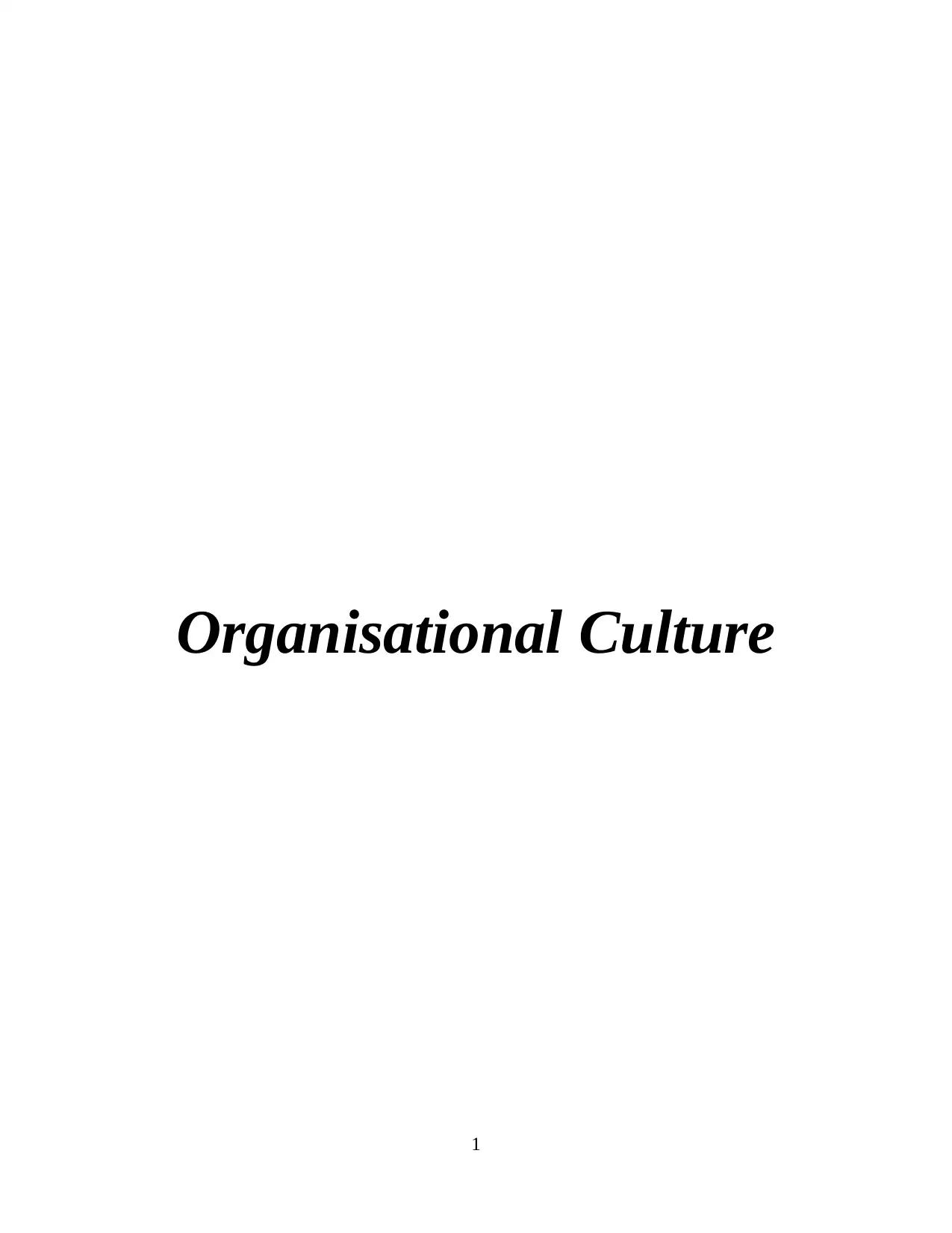
Organisational Culture
1
1
Paraphrase This Document
Need a fresh take? Get an instant paraphrase of this document with our AI Paraphraser
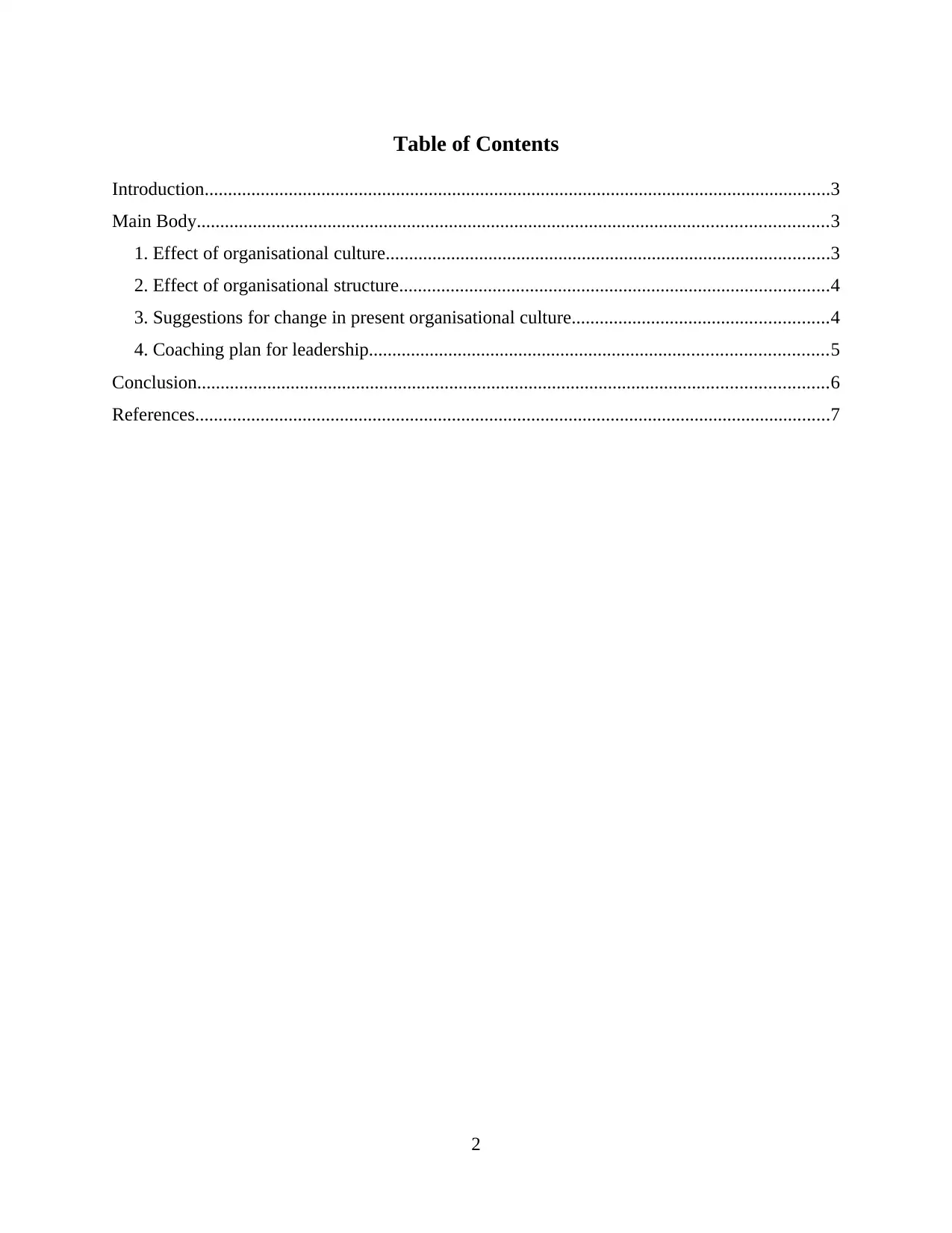
Table of Contents
Introduction......................................................................................................................................3
Main Body.......................................................................................................................................3
1. Effect of organisational culture...............................................................................................3
2. Effect of organisational structure............................................................................................4
3. Suggestions for change in present organisational culture.......................................................4
4. Coaching plan for leadership..................................................................................................5
Conclusion.......................................................................................................................................6
References........................................................................................................................................7
2
Introduction......................................................................................................................................3
Main Body.......................................................................................................................................3
1. Effect of organisational culture...............................................................................................3
2. Effect of organisational structure............................................................................................4
3. Suggestions for change in present organisational culture.......................................................4
4. Coaching plan for leadership..................................................................................................5
Conclusion.......................................................................................................................................6
References........................................................................................................................................7
2
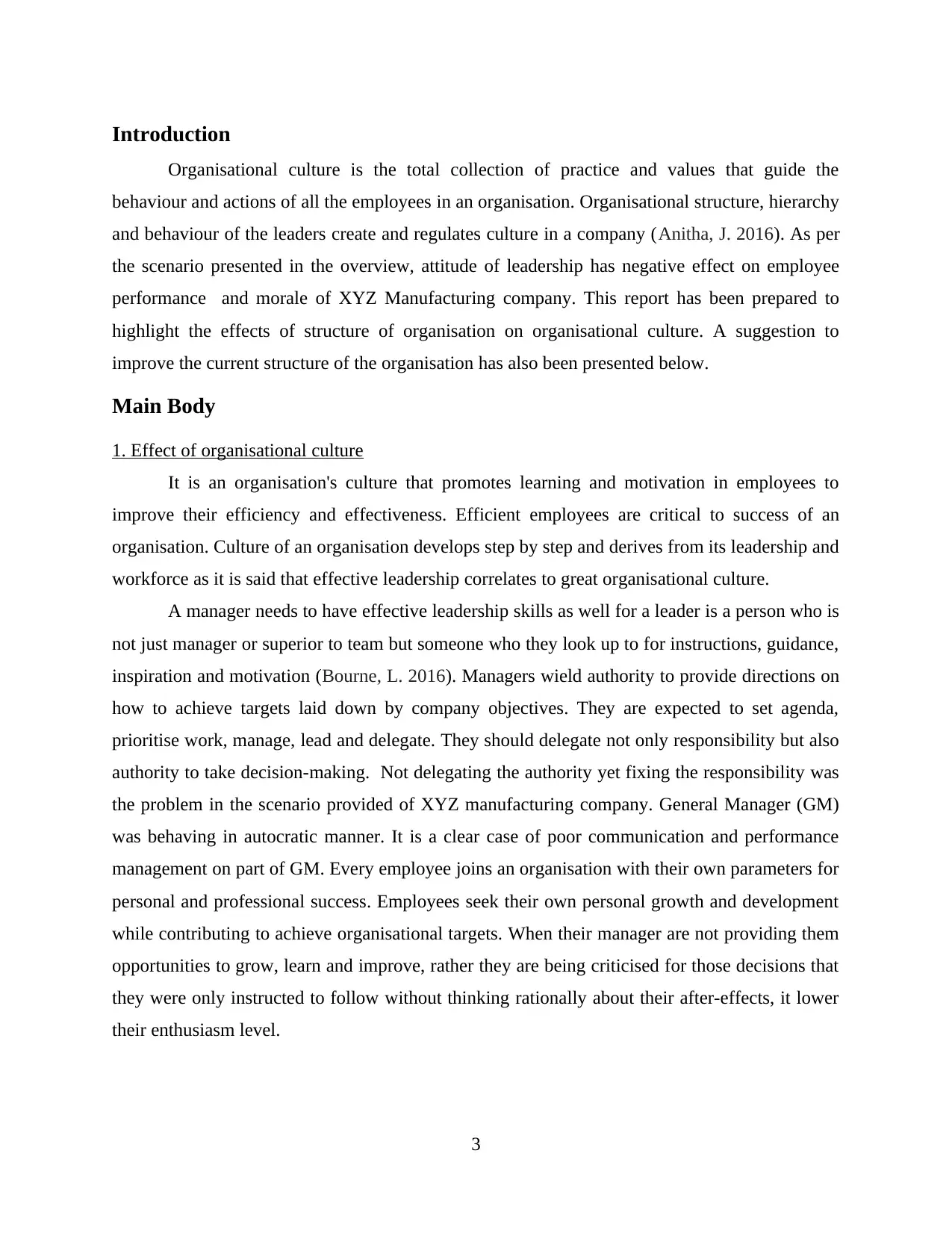
Introduction
Organisational culture is the total collection of practice and values that guide the
behaviour and actions of all the employees in an organisation. Organisational structure, hierarchy
and behaviour of the leaders create and regulates culture in a company (Anitha, J. 2016). As per
the scenario presented in the overview, attitude of leadership has negative effect on employee
performance and morale of XYZ Manufacturing company. This report has been prepared to
highlight the effects of structure of organisation on organisational culture. A suggestion to
improve the current structure of the organisation has also been presented below.
Main Body
1. Effect of organisational culture
It is an organisation's culture that promotes learning and motivation in employees to
improve their efficiency and effectiveness. Efficient employees are critical to success of an
organisation. Culture of an organisation develops step by step and derives from its leadership and
workforce as it is said that effective leadership correlates to great organisational culture.
A manager needs to have effective leadership skills as well for a leader is a person who is
not just manager or superior to team but someone who they look up to for instructions, guidance,
inspiration and motivation (Bourne, L. 2016). Managers wield authority to provide directions on
how to achieve targets laid down by company objectives. They are expected to set agenda,
prioritise work, manage, lead and delegate. They should delegate not only responsibility but also
authority to take decision-making. Not delegating the authority yet fixing the responsibility was
the problem in the scenario provided of XYZ manufacturing company. General Manager (GM)
was behaving in autocratic manner. It is a clear case of poor communication and performance
management on part of GM. Every employee joins an organisation with their own parameters for
personal and professional success. Employees seek their own personal growth and development
while contributing to achieve organisational targets. When their manager are not providing them
opportunities to grow, learn and improve, rather they are being criticised for those decisions that
they were only instructed to follow without thinking rationally about their after-effects, it lower
their enthusiasm level.
3
Organisational culture is the total collection of practice and values that guide the
behaviour and actions of all the employees in an organisation. Organisational structure, hierarchy
and behaviour of the leaders create and regulates culture in a company (Anitha, J. 2016). As per
the scenario presented in the overview, attitude of leadership has negative effect on employee
performance and morale of XYZ Manufacturing company. This report has been prepared to
highlight the effects of structure of organisation on organisational culture. A suggestion to
improve the current structure of the organisation has also been presented below.
Main Body
1. Effect of organisational culture
It is an organisation's culture that promotes learning and motivation in employees to
improve their efficiency and effectiveness. Efficient employees are critical to success of an
organisation. Culture of an organisation develops step by step and derives from its leadership and
workforce as it is said that effective leadership correlates to great organisational culture.
A manager needs to have effective leadership skills as well for a leader is a person who is
not just manager or superior to team but someone who they look up to for instructions, guidance,
inspiration and motivation (Bourne, L. 2016). Managers wield authority to provide directions on
how to achieve targets laid down by company objectives. They are expected to set agenda,
prioritise work, manage, lead and delegate. They should delegate not only responsibility but also
authority to take decision-making. Not delegating the authority yet fixing the responsibility was
the problem in the scenario provided of XYZ manufacturing company. General Manager (GM)
was behaving in autocratic manner. It is a clear case of poor communication and performance
management on part of GM. Every employee joins an organisation with their own parameters for
personal and professional success. Employees seek their own personal growth and development
while contributing to achieve organisational targets. When their manager are not providing them
opportunities to grow, learn and improve, rather they are being criticised for those decisions that
they were only instructed to follow without thinking rationally about their after-effects, it lower
their enthusiasm level.
3
⊘ This is a preview!⊘
Do you want full access?
Subscribe today to unlock all pages.

Trusted by 1+ million students worldwide
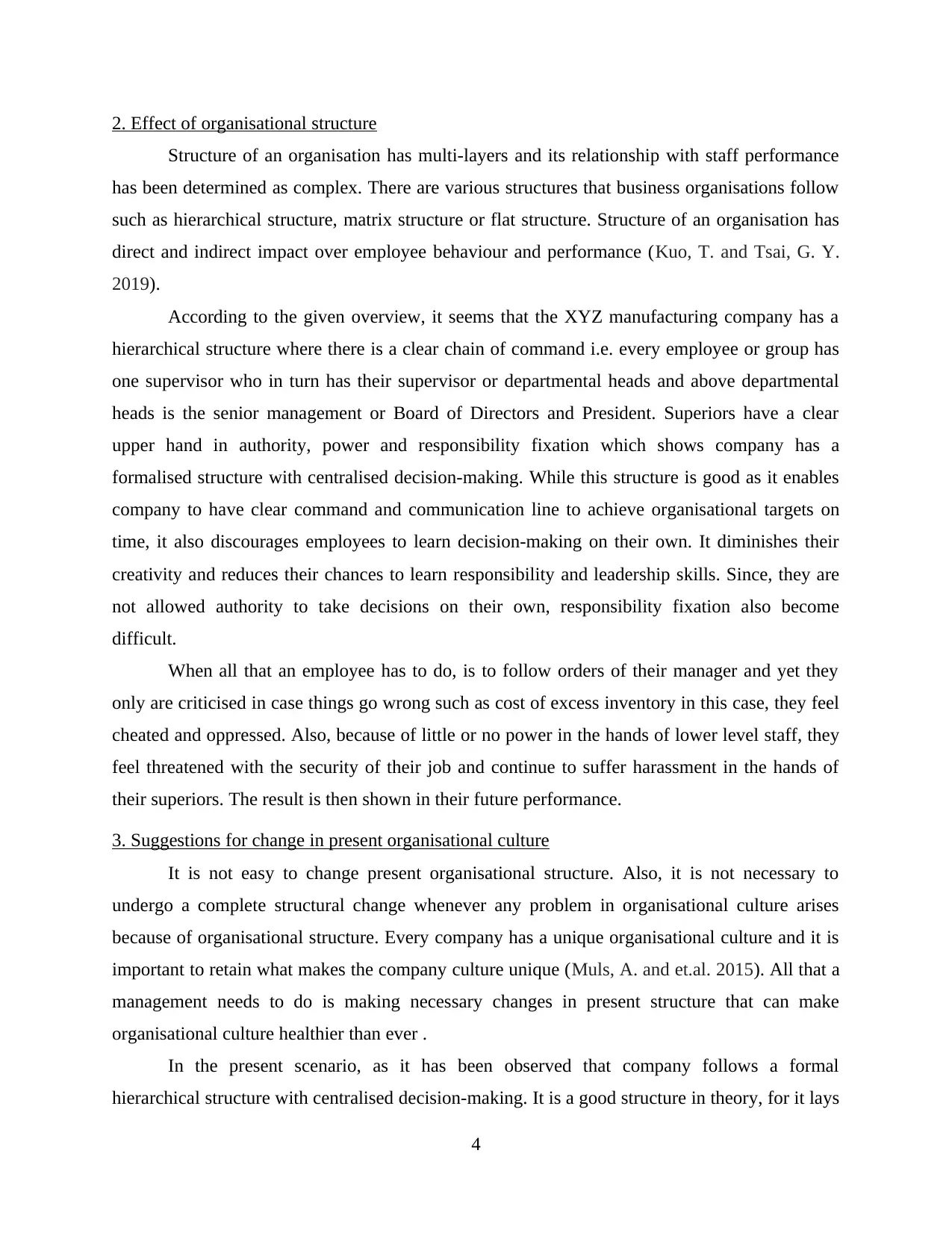
2. Effect of organisational structure
Structure of an organisation has multi-layers and its relationship with staff performance
has been determined as complex. There are various structures that business organisations follow
such as hierarchical structure, matrix structure or flat structure. Structure of an organisation has
direct and indirect impact over employee behaviour and performance (Kuo, T. and Tsai, G. Y.
2019).
According to the given overview, it seems that the XYZ manufacturing company has a
hierarchical structure where there is a clear chain of command i.e. every employee or group has
one supervisor who in turn has their supervisor or departmental heads and above departmental
heads is the senior management or Board of Directors and President. Superiors have a clear
upper hand in authority, power and responsibility fixation which shows company has a
formalised structure with centralised decision-making. While this structure is good as it enables
company to have clear command and communication line to achieve organisational targets on
time, it also discourages employees to learn decision-making on their own. It diminishes their
creativity and reduces their chances to learn responsibility and leadership skills. Since, they are
not allowed authority to take decisions on their own, responsibility fixation also become
difficult.
When all that an employee has to do, is to follow orders of their manager and yet they
only are criticised in case things go wrong such as cost of excess inventory in this case, they feel
cheated and oppressed. Also, because of little or no power in the hands of lower level staff, they
feel threatened with the security of their job and continue to suffer harassment in the hands of
their superiors. The result is then shown in their future performance.
3. Suggestions for change in present organisational culture
It is not easy to change present organisational structure. Also, it is not necessary to
undergo a complete structural change whenever any problem in organisational culture arises
because of organisational structure. Every company has a unique organisational culture and it is
important to retain what makes the company culture unique (Muls, A. and et.al. 2015). All that a
management needs to do is making necessary changes in present structure that can make
organisational culture healthier than ever .
In the present scenario, as it has been observed that company follows a formal
hierarchical structure with centralised decision-making. It is a good structure in theory, for it lays
4
Structure of an organisation has multi-layers and its relationship with staff performance
has been determined as complex. There are various structures that business organisations follow
such as hierarchical structure, matrix structure or flat structure. Structure of an organisation has
direct and indirect impact over employee behaviour and performance (Kuo, T. and Tsai, G. Y.
2019).
According to the given overview, it seems that the XYZ manufacturing company has a
hierarchical structure where there is a clear chain of command i.e. every employee or group has
one supervisor who in turn has their supervisor or departmental heads and above departmental
heads is the senior management or Board of Directors and President. Superiors have a clear
upper hand in authority, power and responsibility fixation which shows company has a
formalised structure with centralised decision-making. While this structure is good as it enables
company to have clear command and communication line to achieve organisational targets on
time, it also discourages employees to learn decision-making on their own. It diminishes their
creativity and reduces their chances to learn responsibility and leadership skills. Since, they are
not allowed authority to take decisions on their own, responsibility fixation also become
difficult.
When all that an employee has to do, is to follow orders of their manager and yet they
only are criticised in case things go wrong such as cost of excess inventory in this case, they feel
cheated and oppressed. Also, because of little or no power in the hands of lower level staff, they
feel threatened with the security of their job and continue to suffer harassment in the hands of
their superiors. The result is then shown in their future performance.
3. Suggestions for change in present organisational culture
It is not easy to change present organisational structure. Also, it is not necessary to
undergo a complete structural change whenever any problem in organisational culture arises
because of organisational structure. Every company has a unique organisational culture and it is
important to retain what makes the company culture unique (Muls, A. and et.al. 2015). All that a
management needs to do is making necessary changes in present structure that can make
organisational culture healthier than ever .
In the present scenario, as it has been observed that company follows a formal
hierarchical structure with centralised decision-making. It is a good structure in theory, for it lays
4
Paraphrase This Document
Need a fresh take? Get an instant paraphrase of this document with our AI Paraphraser
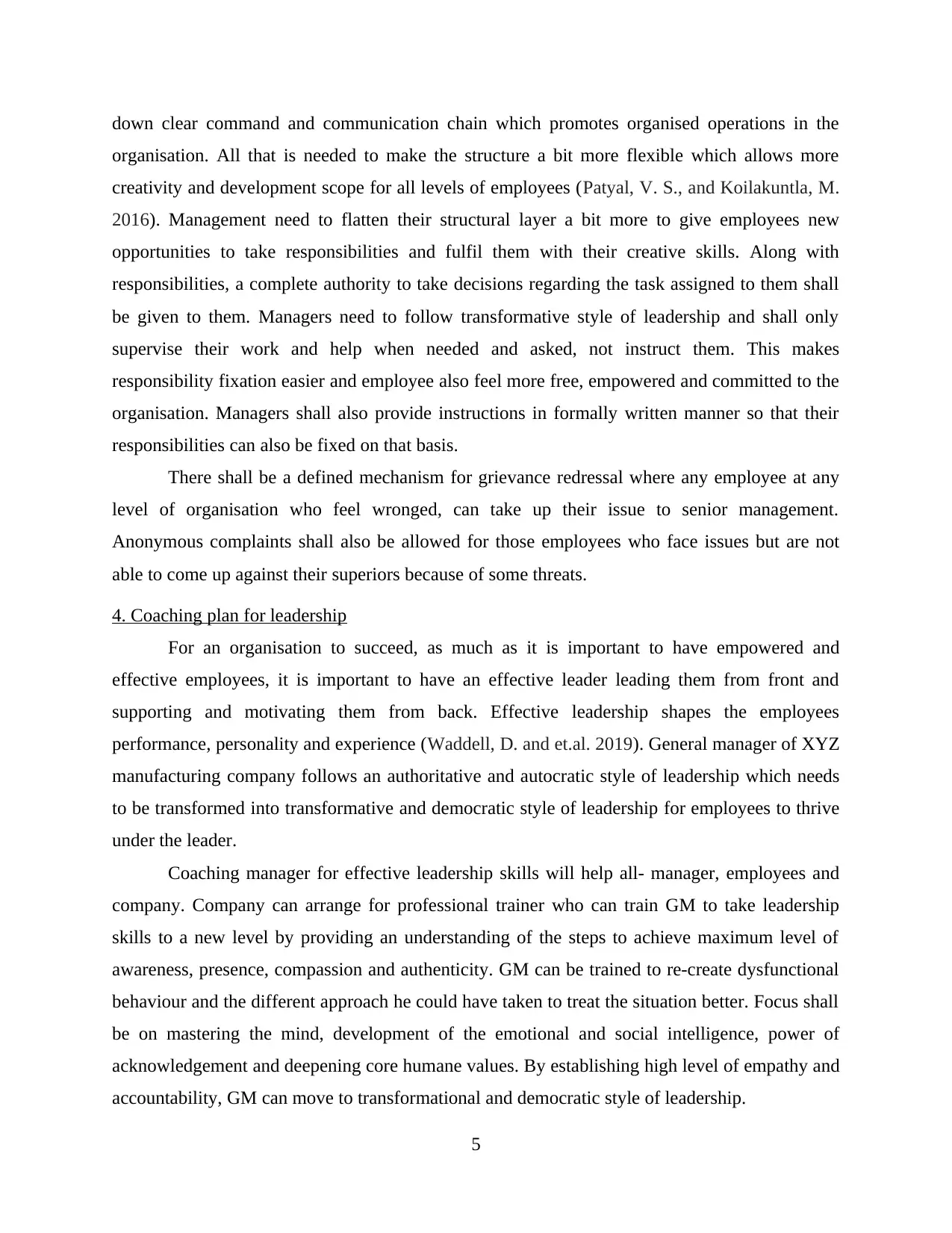
down clear command and communication chain which promotes organised operations in the
organisation. All that is needed to make the structure a bit more flexible which allows more
creativity and development scope for all levels of employees (Patyal, V. S., and Koilakuntla, M.
2016). Management need to flatten their structural layer a bit more to give employees new
opportunities to take responsibilities and fulfil them with their creative skills. Along with
responsibilities, a complete authority to take decisions regarding the task assigned to them shall
be given to them. Managers need to follow transformative style of leadership and shall only
supervise their work and help when needed and asked, not instruct them. This makes
responsibility fixation easier and employee also feel more free, empowered and committed to the
organisation. Managers shall also provide instructions in formally written manner so that their
responsibilities can also be fixed on that basis.
There shall be a defined mechanism for grievance redressal where any employee at any
level of organisation who feel wronged, can take up their issue to senior management.
Anonymous complaints shall also be allowed for those employees who face issues but are not
able to come up against their superiors because of some threats.
4. Coaching plan for leadership
For an organisation to succeed, as much as it is important to have empowered and
effective employees, it is important to have an effective leader leading them from front and
supporting and motivating them from back. Effective leadership shapes the employees
performance, personality and experience (Waddell, D. and et.al. 2019). General manager of XYZ
manufacturing company follows an authoritative and autocratic style of leadership which needs
to be transformed into transformative and democratic style of leadership for employees to thrive
under the leader.
Coaching manager for effective leadership skills will help all- manager, employees and
company. Company can arrange for professional trainer who can train GM to take leadership
skills to a new level by providing an understanding of the steps to achieve maximum level of
awareness, presence, compassion and authenticity. GM can be trained to re-create dysfunctional
behaviour and the different approach he could have taken to treat the situation better. Focus shall
be on mastering the mind, development of the emotional and social intelligence, power of
acknowledgement and deepening core humane values. By establishing high level of empathy and
accountability, GM can move to transformational and democratic style of leadership.
5
organisation. All that is needed to make the structure a bit more flexible which allows more
creativity and development scope for all levels of employees (Patyal, V. S., and Koilakuntla, M.
2016). Management need to flatten their structural layer a bit more to give employees new
opportunities to take responsibilities and fulfil them with their creative skills. Along with
responsibilities, a complete authority to take decisions regarding the task assigned to them shall
be given to them. Managers need to follow transformative style of leadership and shall only
supervise their work and help when needed and asked, not instruct them. This makes
responsibility fixation easier and employee also feel more free, empowered and committed to the
organisation. Managers shall also provide instructions in formally written manner so that their
responsibilities can also be fixed on that basis.
There shall be a defined mechanism for grievance redressal where any employee at any
level of organisation who feel wronged, can take up their issue to senior management.
Anonymous complaints shall also be allowed for those employees who face issues but are not
able to come up against their superiors because of some threats.
4. Coaching plan for leadership
For an organisation to succeed, as much as it is important to have empowered and
effective employees, it is important to have an effective leader leading them from front and
supporting and motivating them from back. Effective leadership shapes the employees
performance, personality and experience (Waddell, D. and et.al. 2019). General manager of XYZ
manufacturing company follows an authoritative and autocratic style of leadership which needs
to be transformed into transformative and democratic style of leadership for employees to thrive
under the leader.
Coaching manager for effective leadership skills will help all- manager, employees and
company. Company can arrange for professional trainer who can train GM to take leadership
skills to a new level by providing an understanding of the steps to achieve maximum level of
awareness, presence, compassion and authenticity. GM can be trained to re-create dysfunctional
behaviour and the different approach he could have taken to treat the situation better. Focus shall
be on mastering the mind, development of the emotional and social intelligence, power of
acknowledgement and deepening core humane values. By establishing high level of empathy and
accountability, GM can move to transformational and democratic style of leadership.
5
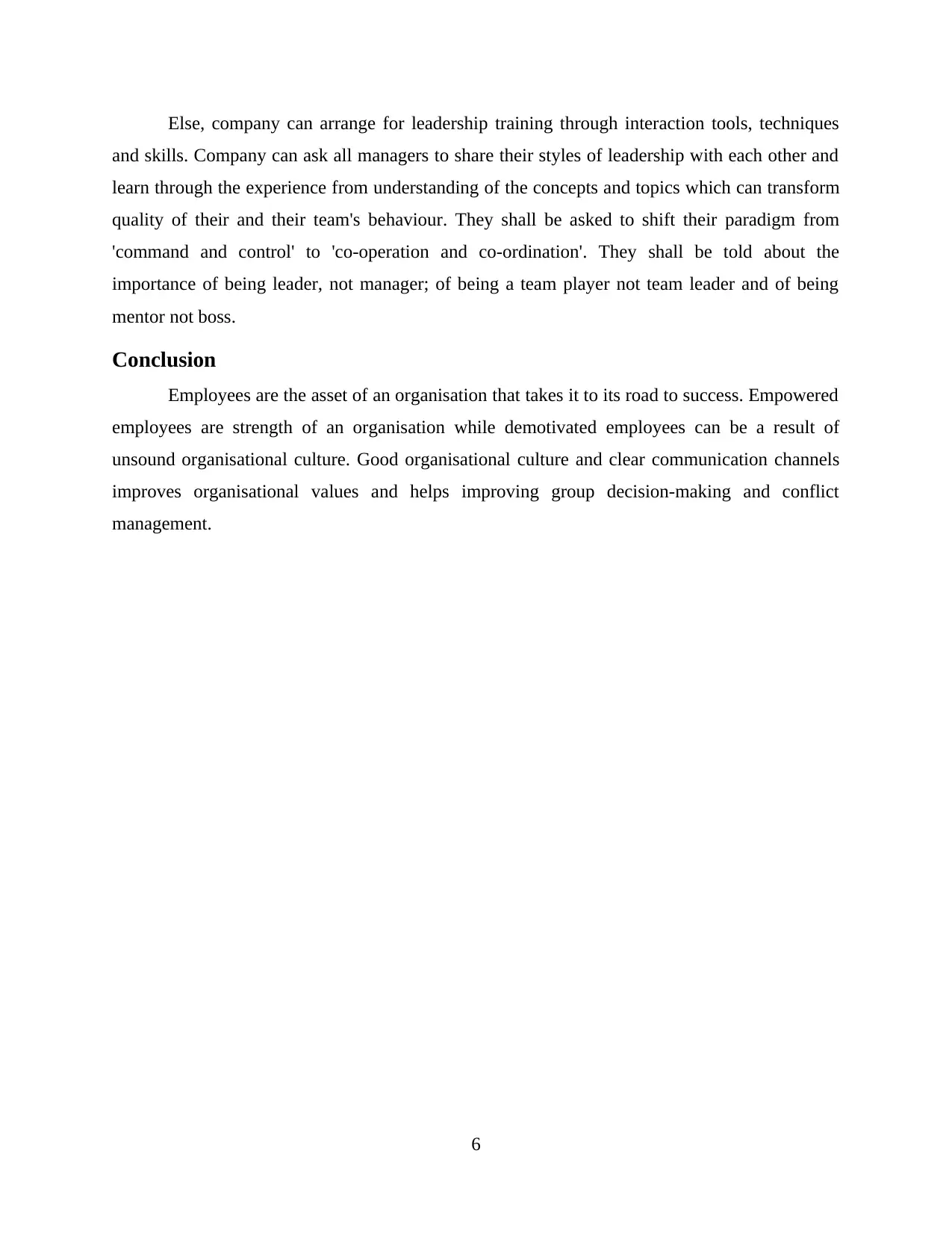
Else, company can arrange for leadership training through interaction tools, techniques
and skills. Company can ask all managers to share their styles of leadership with each other and
learn through the experience from understanding of the concepts and topics which can transform
quality of their and their team's behaviour. They shall be asked to shift their paradigm from
'command and control' to 'co-operation and co-ordination'. They shall be told about the
importance of being leader, not manager; of being a team player not team leader and of being
mentor not boss.
Conclusion
Employees are the asset of an organisation that takes it to its road to success. Empowered
employees are strength of an organisation while demotivated employees can be a result of
unsound organisational culture. Good organisational culture and clear communication channels
improves organisational values and helps improving group decision-making and conflict
management.
6
and skills. Company can ask all managers to share their styles of leadership with each other and
learn through the experience from understanding of the concepts and topics which can transform
quality of their and their team's behaviour. They shall be asked to shift their paradigm from
'command and control' to 'co-operation and co-ordination'. They shall be told about the
importance of being leader, not manager; of being a team player not team leader and of being
mentor not boss.
Conclusion
Employees are the asset of an organisation that takes it to its road to success. Empowered
employees are strength of an organisation while demotivated employees can be a result of
unsound organisational culture. Good organisational culture and clear communication channels
improves organisational values and helps improving group decision-making and conflict
management.
6
⊘ This is a preview!⊘
Do you want full access?
Subscribe today to unlock all pages.

Trusted by 1+ million students worldwide
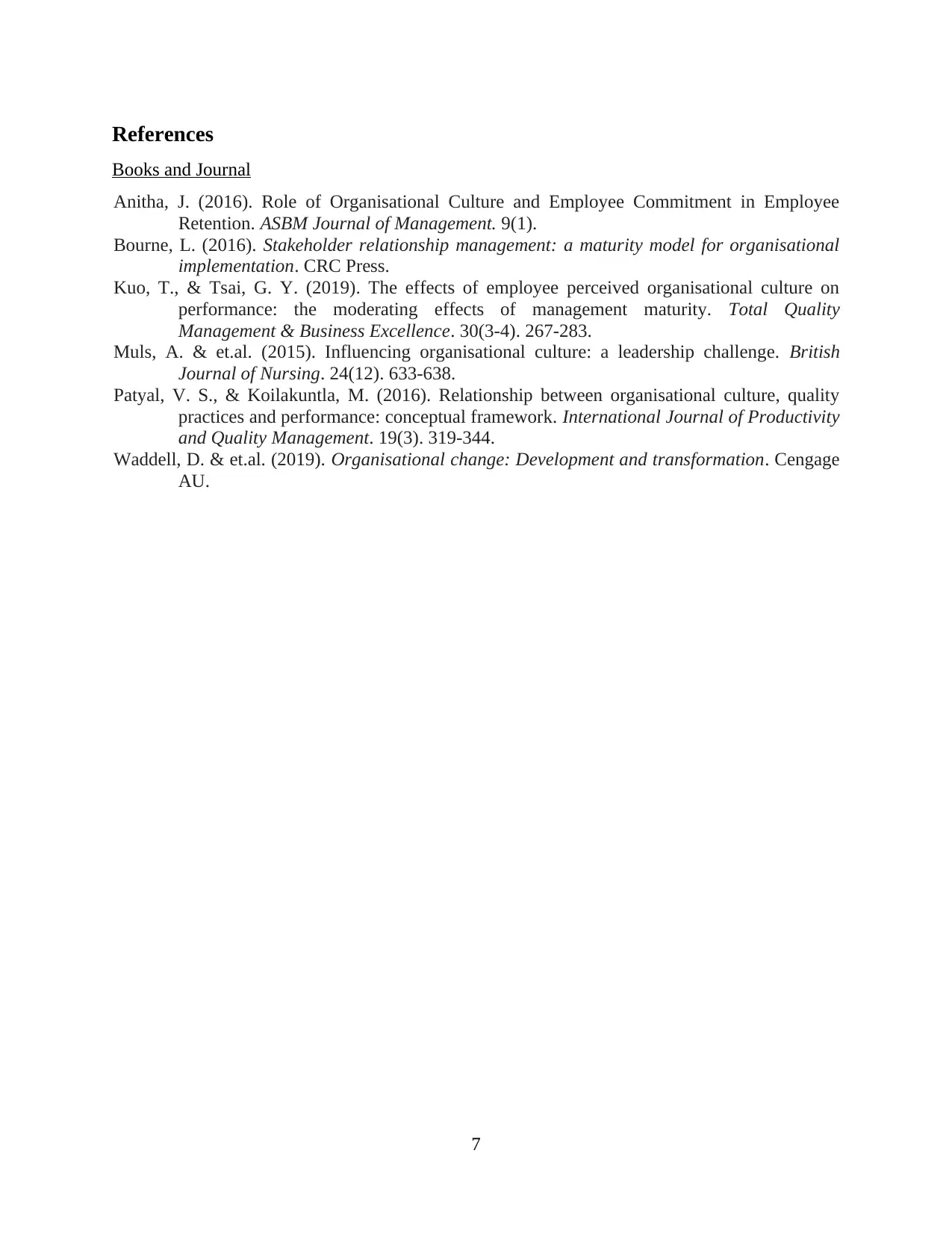
References
Books and Journal
Anitha, J. (2016). Role of Organisational Culture and Employee Commitment in Employee
Retention. ASBM Journal of Management. 9(1).
Bourne, L. (2016). Stakeholder relationship management: a maturity model for organisational
implementation. CRC Press.
Kuo, T., & Tsai, G. Y. (2019). The effects of employee perceived organisational culture on
performance: the moderating effects of management maturity. Total Quality
Management & Business Excellence. 30(3-4). 267-283.
Muls, A. & et.al. (2015). Influencing organisational culture: a leadership challenge. British
Journal of Nursing. 24(12). 633-638.
Patyal, V. S., & Koilakuntla, M. (2016). Relationship between organisational culture, quality
practices and performance: conceptual framework. International Journal of Productivity
and Quality Management. 19(3). 319-344.
Waddell, D. & et.al. (2019). Organisational change: Development and transformation. Cengage
AU.
7
Books and Journal
Anitha, J. (2016). Role of Organisational Culture and Employee Commitment in Employee
Retention. ASBM Journal of Management. 9(1).
Bourne, L. (2016). Stakeholder relationship management: a maturity model for organisational
implementation. CRC Press.
Kuo, T., & Tsai, G. Y. (2019). The effects of employee perceived organisational culture on
performance: the moderating effects of management maturity. Total Quality
Management & Business Excellence. 30(3-4). 267-283.
Muls, A. & et.al. (2015). Influencing organisational culture: a leadership challenge. British
Journal of Nursing. 24(12). 633-638.
Patyal, V. S., & Koilakuntla, M. (2016). Relationship between organisational culture, quality
practices and performance: conceptual framework. International Journal of Productivity
and Quality Management. 19(3). 319-344.
Waddell, D. & et.al. (2019). Organisational change: Development and transformation. Cengage
AU.
7
1 out of 7
Related Documents
Your All-in-One AI-Powered Toolkit for Academic Success.
+13062052269
info@desklib.com
Available 24*7 on WhatsApp / Email
![[object Object]](/_next/static/media/star-bottom.7253800d.svg)
Unlock your academic potential
Copyright © 2020–2025 A2Z Services. All Rights Reserved. Developed and managed by ZUCOL.




